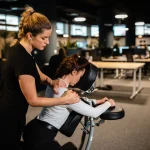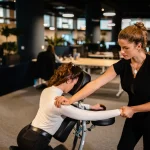Trigger Point Massage Therapy
Trigger point massages involves applying direct pressure to trigger points or muscular knots throughout the body which can be uncomfortable or painful at first. Communication is very important during trigger point therapy so the therapist can adjust their pressure when needed. The pain should not go beyond a hurt so good. Each pain point or muscular knot may be pressed or crunched, massaged with and against the muscle fibers, and stretched.
Trigger point therapy can releases the tightest areas of your body (often the neck and low back), helping improve range of motion, posture, releases impinged nerves, and improves alignment. Regular sessions can help with chronic pain, which is sometimes the result of referral pain from trigger points. Sessions can also help with athletic performance and acute pain from repetitive motions and injuries.
Precautions & Contraindications: Massage can be very therapeutic for many medical conditions. However, in some cases it is best to obtain a written doctors referral. Massage therapists, may not, under the written law, attempt to diagnose any medical conditions. If you have any questions or concerns, please contact us for more information.
Additional Tip: May want to avoid eating a heavy meal before a massage.
Contraindications to Receiving Massage Therapy: Massage treatment is relaxing and natural. It is generally considered a safe treatment for most people however, there are three types of “Contraindications” where massage could be provided but may be limited or, massage is not recommended at that time.













